(WARNING: Some photos may be upsetting to some people.)
Last month, Sheila and I had a chance to attend a simulation with law enforcement, firefighters, EMS professionals, and students in action at a multi-casualty accident scene. We saw how their skills are tested when a drunk driver runs a traffic light and smashes into a yard sale, killing and maiming several people.
How do the EMS, firefighters, and police learn to work together to handle the horrific scene? They practice, in demonstrations just like this one.
Typically, an onlooker at an accident calls 911, gives whatever details are available – location of the accident, number of people injured, whether or not there is more than one car involved. Rarely are the callers calm and collected, but the dispatcher has to keep his/her cool, no matter how bad it sounds. The information is passed on to the agencies that can help and usually, the closest one to the accident site responds.
The First Responder assesses the accident, notifies Dispatch as to what other help may be needed, and establishes a perimeter. In this scenario, the First Responder was a deputy from the Sheriff’s Department.
He took a look at the scene, called for backup, made some decisions, checked to see who was still alive, and helped those he could while he waited.
Fire and Rescue arrived at the scene next.
The driver of the car did not appear to be injured, was not pinned inside, and no gasoline was leaking from anywhere, but the Firefighters were needed to lift the car off two victims who were trapped underneath it. One was ‘dead,’ but one was still alive.
The Firefighters used a Hurst Spreader (commonly known as the ‘jaws of life’) in addition to assorted chocks and lumber in order to stabilize the car before pulling the victims free.
Standard procedure indicates that after the initial assessment and after additional help has arrived, law enforcement takes care of the driver issues and rescue takes care of the victims. Law enforcement continues to help where needed.
A Breathalyzer test was administered to the driver, since the road was not wet, and there was no other apparent reason for him to plow into a front yard full of people. Witness statements were taken from those involved at the scene. Onlookers were kept at a safe distance throughout the simulation.
The ambulances arrived and EMS workers evaluated the injured people.
While cries of “Please help us,” and “She needs help,” were heard continuously in the background, one of the EMS workers assigned black, red and yellow tags to the victims.
Yellow tag: broken bones, but alert
Red tag: will die if not treated immediately, still breathing on own
Black tag: not breathing
After the car was elevated, the person underneath was pulled out, strapped onto a stretcher, then transported to the hospital.
EMS workers enlisted the aid of lightly injured victims and urged them to talk to the more seriously hurt. Keeping the injured awake and alert was an important part of assessment. If the victims lost consciousness, or had slurred speech, then they went to the head of the line for treatment and transport.
One of the EMS gals told us later that it’s not unusual to have to talk people into leaving others behind in order to get help for themselves at the hospital. Some victims appear to be fine, but wander around the area in confusion and shock, unaware of cuts and more serious injuries of their own.
One of the victims who kept crying out for help for others, eventually collapsed, was put on backboard and then lifted to a gurney for transport.
The last victim was treated and transported, the driver was arrested and taken to jail and all that remained was the cleanup. The firefighters took off their jackets, gathered their gear and re-stowed it in the rescue truck.
What was the difference between this simulation and the explosion simulation we witnessed last year? That one included unknown perpetrators and a continuing threat that widened from the campus to the airport and public transportation. Both law enforcement and EMS personnel gathered evidence at the scene (which in some cases was embedded in the victims).
At the Yard Sale simulation, the evidence collected was in the form of photos of the scene, the Breathalyzer test, as well as witness statements from onlookers and victims. The threat was specific to the scene and dealt with.
Both were crime scenes, but played out quite differently.
As we saw last year at the explosion simulation, the three groups at the ‘Yard Sale’ were professional and took the simulation seriously. Their interaction appeared seamless and we were impressed by the way they worked near each other in order to complete their assigned tasks and then jumped in to help each other when needed. Well done!
*Photos by Patti Phillips, except one.
All taken at Guilford County Community College, in North Carolina.
*Photo taken and shared by Terry Odell, writer. Thanks! Follow her blog and find out about her books at www.terryodell.com

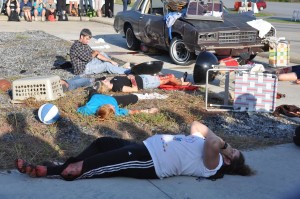
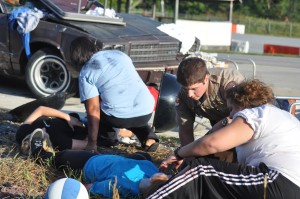
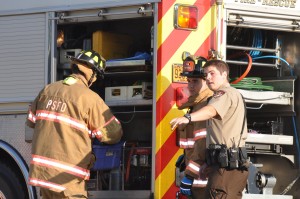
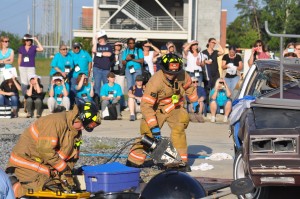
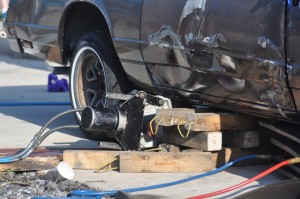
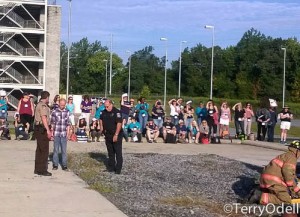
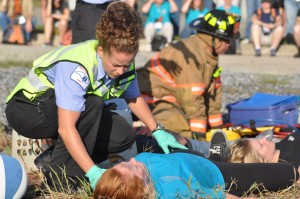
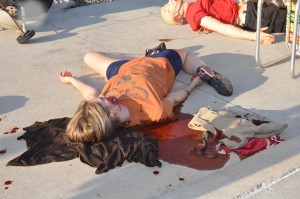
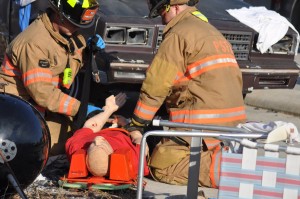
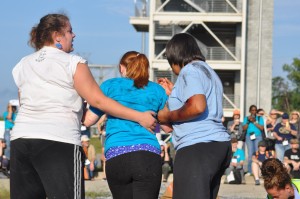
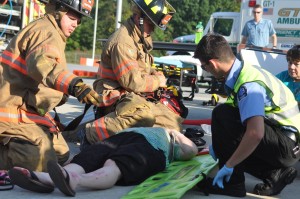
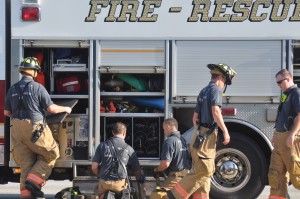
Fascinating, and so instructive and informative. Thanks for sharing.
Thanks, Jane! The participants did a great job and the photo ops were abundant. 🙂
This was a great demonstration at WPA 2014. I was impressed with the first responders.
Completely agree, Jamie! Another outstanding demo at the Writers’ Police Academy. 🙂
Thanks, Patti, for this informative write up. And deep thanks always to first responders–and second and third–who put their well-being on the line for us every single day.
Hi Jenny,
Glad you found the article helpful!
I’m always amazed at the variety of tasks the three groups are required to perform every day they leave the station. Yes, deep thanks to all the first responders! 🙂
A comprehensive look at an accident scene that shows what really happens beind-the-scenes, Patti, and a great example of how these agencies work hand-in-hand to deal with such a calamity.
Thanks, Tom. 🙂
One of the many cool things about the simulation was that we knew there were some students involved as part of their field training. What a great way to practice the strategies taught in classroom lectures!
Good info to keep in mind as I write a scene, sketched out lightly already, about a car crash. Thanks for the ever-useful and concise info.
Happy it helped! 🙂